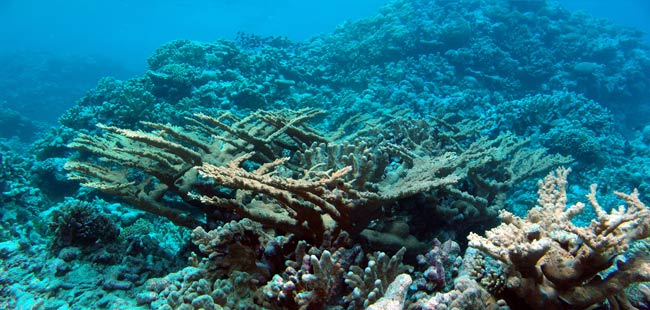
Rare Coral Discovered in Pacific Ocean

What could be the world's rarest coral has been discovered in the remote North Pacific Ocean.
The Pacific elkhorn coral (Acropora rotumana) — with branches like an elk's antlers — was found during an underwater survey of the Arno atoll in the Marshall Islands.
Corals are tiny creatures that live in skeleton-covered colonies, creating the illusion that a coral community is one single organism. This newfound coral colony may be the first time this species has been spotted in more than 100 years, according to researchers at the Centre of Excellence for Coral Reef Studies (CoECRS) in Queensland, Australia.
"When I first saw it, I was absolutely stunned," said research team leader Zoe Richards of CoECRS.
The huge coral colonies were 16 feet (5 meters) across and nearly 7 feet (2 m) high and "were like nothing I'd seen before in the Pacific Ocean," Richards said.
The coral colony looks like the critically endangered elkhorn coral (Acropora palmata) of the Atlantic Ocean, but genetic analysis has shown that the Atlantic and Pacific varieties are different species.
The Pacific elkhorn is of the Acropora genus, the dominant genus of reef-building corals, the researchers said, so learning how the Pacific version lives will provide clues about these exotic marine creatures and will help determine their conservation status.
Sign up for the Live Science daily newsletter now
Get the world’s most fascinating discoveries delivered straight to your inbox.
"So far I have only found this new population of coral to occur along a small stretch of reef at a single atoll in the Marshalls group," Richards said. "It grows in relatively shallow water along the exposed reef front and, so far, fewer than 200 colonies are known from that small area."
The Pacific elkhorn coral colonies are the largest of all the Acropora colonies observed at Arno Atoll, indicating that these are relatively old, Richards said.
The Pacific elkhorn coral colony was a rare find, but it may not be an entirely new species. Corals fitting the description of the Pacific elkhorn were first described in 1898 near Fiji in the South Pacific, but scientists don't have enough genetic information from this earlier find to say if the corals are a match, Richards said.
The Atlantic relative, A. palmata is regarded by most marine researchers as the outstanding symbol of the plight of Caribbean corals. It is rated as critically endangered after vanishing from most of its Caribbean reef habitat in recent decades.
"When Zoe showed me pictures of the Pacific elkhorn, I was shocked," said coral geneticist David Miller of CoECRS and James Cook University, also in Queensland. "The colonies look just like the critically endangered Caribbean species A. palmata, one of the most distinctive of all corals. The fact that these colonies might represent a species that has not been seen for over a hundred years (A. rotumana) says something about how much we know about the remote reefs of the North Pacific," Miller said.
The newfound coral colony is detailed in the June 2 edition of the journal Systematics and Biodiversity.
- Images: Incredible Coral
- Worlds Apart: A Cautionary Tale of Two Coral Atolls
- The World's Biggest Oceans and Seas
This article was provided by OurAmazingPlanet, a sister site to LiveScience.










